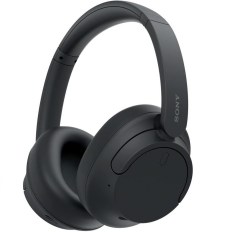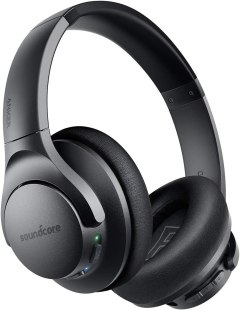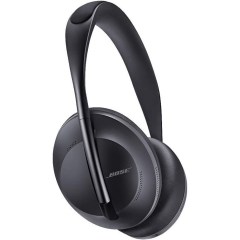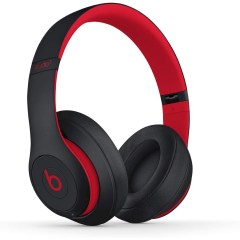Buying guide for best headphones
Many of us never go far without our headphones, so it’s important to choose the right pair. Whether you're an avid audiophile seeking pristine sound quality, a frequent flyer seeking peace and relaxation or a casual listener who wants reliable and comfortable cans, we're here to help you navigate the vast sea of options.
If this is your first time buying headphones in a while, you might be wondering whether wireless or wired headphones are right for you. And, naturally, sound quality takes center stage when evaluating headphones. You want headphones that can reproduce accurate and immersive audio, whether you’re listening to music, podcasts or movies.
Noise cancelation is an increasingly sought-after feature in headphones. It lets you immerse yourself in music without distraction or provides a peaceful oasis in a noisy environment. You’ll also want to consider comfort when buying headphones. Hours of continuous usage can be a breeze or a burden depending on the design, weight and materials of your headphones.
We tested and researched headphones and found the Sony WH-CH720N Noise-Canceling Wireless Headphones to be the very best. A solid mid-range choice for buyers who want good audio quality without spending too much, they're light and comfortable to wear, making them ideal for on-the-go use. We also love Soundcore Anker Life Q20 Hybrid Active Noise-Canceling Headphones as an option for buyers on a tighter budget.
Best headphones
Thanks to their wireless design, you won't have to worry about knots in your cables or being tethered to your music player. The battery lasts for 35 hours and there's a quick-charge option that gives you an hour of playback when you charge them for just three minutes. The audio is clear and well-balanced, so they're great for listening to music, podcasts, TV or movies.
The microphone's Precise Voice Pickup technology means you're heard loud and clear when you make calls and makes it easier for voice assistants to pick up your commands. They're light and well-padded, so they're comfortable to wear. The active noise cancelation does a decent job of blocking out sounds, although it lacks compared to top-end headphones.
If you're looking for wireless headphones on a budget, these should be high on your list of products to consider. We tested them to find out how they performed and we were happy with the overall quality for the price point.
The battery can last for up to 60 hours in standard music mode or around 40 hours with active noise cancelation engaged. Of course, the sound quality won't compete with high-end headphones, but it's fine for casual listeners. In our testing, we found the sound quality solid overall, but the bass was especially impressive with the noise cancelation switched off.
We tested out the Bose 700s to see if these wireless headphones stood up to the quality we'd expect from Bose. We found the sound crisp and vibrant overall, while the bass was deep and rich. These headphones reproduce audio faithfully, so everything sounds balanced and lifelike.
We found them comfortable to wear, with no irritation from the earcups or the headband. The high-quality mic picked up voices well, so it was a pleasure to use these headphones for phone calls. The noise-cancelation was effective in our tests, although we're not sure there was a huge difference between the 11 noise-canceling levels on offer.
These headphones give you studio-quality performance in a convenient wireless package. The battery lasts up to 22 hours with active noise cancelation on — and even longer without. The sound is well-balanced and clear and the headphones support spatial audio for an immersive listening experience.
The noise-canceling technology works effectively in a range of environments, including noisy surroundings, so they're great for loud workplaces or busy city streets. The microphone has excellent voice pickup, so call clarity is excellent. They're padded for all-day comfort. Although they pair with Apple devices automatically, they also work for Android using the Beats app.
You might be used to AirPods earbuds, but AirPods Max are wireless over-ear headphones with highly impressive sound quality. They contain Apple-designed dynamic drivers that reproduce sound faithfully for high-fidelity audio. The spatial audio makes music and other sounds feel true to life.
The active noise cancelation blocks out the world around you effectively. However, there's also a transparent mode for when you need to be aware of your surroundings. The battery lasts around 20 continuous hours, even with noise cancelation and spatial audio switched on. The mic picks up your voice easily, so phone calls are clear and your voice assistant won't miss a command. The mesh memory foam ear pads are very comfortable.
If you're looking for impressive headphones to listen to TV and movies, you should consider the Sennheiser RS 175 RF Wireless Headphone System. It consists of a wireless receiver that links up to your TV and a set of headphones, so you can listen wirelessly, even if your TV isn't Bluetooth-compatible. The batteries last 18 hours so you can complete that "Lord of the Rings" marathon without having to recharge.
The sound is well-balanced and immersive, so you won't miss a thing and can get lost in the world of the movie or TV show you're watching. They're well-padded and comfortable, so you can relax and enjoy your downtime.
Sony's flagship wireless headphones might not be cheap but they're well worth the price tag for serious audiophiles. The audio quality is impeccable, with clear highs and rich lows. So, whether you're listening to music or other types of audio, you won't be disappointed. With eight mics and four processors involved in the active noise cancelation, it probably won't surprise you that it works well.
In addition to the mics used for noise cancelation, there's an array of four mics to pick up your voice, so whoever you're calling will feel like they're in the room with you. The batteries last up to 30 hours and the padding makes them comfortable to wear all day.
We tried out the JLab JBuddies Studio Bluetooth On-Ear Kids Headphones with a young tester to discover whether they're a good choice for kids. Their wireless design makes them tougher for kids to break, while the volume limiter is a must-have for little ears. We found these headphones comfortable, even for kids who are sensitive to wearables.
The battery lasts 13 hours and they maintained a consistent sound quality even when the batteries were close to depletion. They pass muster with kids, looking cool and sophisticated, rather than too childish. The built-in mic lets kids use voice commands or talk on the phone.
These wired headphones are perfect for people who aren't interested in wireless or want more impressive sound quality for their money. These headphones sound incredible, with high-fidelity audio and well-balanced highs, mids and lows. And, there's no need to worry about them running out of battery.
The velour-covered ear pads and padded headband make them comfortable to wear for long periods. Thanks to the open-back design, they deliver a natural tonal balance for some of the most realistic sounds around. However, it means they aren't the best choice for listening out of the house, as they leak sound somewhat and let ambient noise in.
How we tested
We tested out three sets of headphones: the Bose 700s, the Soundcore Anker Life 220s and the JLab Jbuddies headphones for kids. Here's how we tested them and what we looked for.
Ease of use
- Setup: When testing wireless headphones, we looked at how easy they were to set up and pair with other devices.
- Control buttons: We checked how intuitive any onboard control buttons were to use.
Quality
- Audio quality: How your headphones sound is important, so we checked sound quality when listening to a range of audio types.
- Build quality: We assessed how durable the headphones felt and what kind of build quality they had.
- Call quality: We made calls to see how well the mic picked up our voices in a range of conditions.
Other considerations
- Battery life: Running out of battery at a crucial moment is frustrating, so we checked the battery life and whether it lived up to the manufacturers' claims.
- Noise-cancelation: We tested out noise-canceling properties to see how well they performed.
What to know before buying headphones
Wired vs. wireless
Many headphones on the market today are wireless, but there's still a place for wired headphones.
Wireless: Wireless headphones pair with compatible devices via Bluetooth. Since many phones no longer have headphone jacks, wireless headphones have become increasingly popular. They're convenient because you don't have to worry about cables getting tangled or about them breaking due to the connecting wires coming loose.
However, you can only use them with Bluetooth-compatible devices, so if you have an older stereo or TV, you may not be able to use your wireless headphones with it. They're also battery-powered, so you'll need to recharge them regularly.
Wired: Wired headphones might feel like something out of 2010, but some buyers still prefer them. You tend to get better sound quality for your money with wired headphones and you don't need to worry about recharging them. They're also lighter and less bulky than wireless headphones of comparable quality.
On the downside, you're literally tethered to whatever device you're listening to music from, which can be limiting. You'll also find that some phones and tablets don't have headphone jacks, so you'll need to use an adapter.
Sound quality
One of the most important things about your headphones is how they sound. After all, you don't want to pay top dollar for headphones that sound tinny or unrealistic. The audio output is impacted by a number of factors that are worth considering.
Driver type and quality play a vital role. Dynamic drivers are the most common, producing a wide frequency range and powerful bass response. Balanced armature drivers are known for their precision and detail in the mid and high frequencies, while planar magnetic drivers offer exceptional clarity and accuracy.
The frequency response range is also important. This affects headphones’ ability to reproduce sounds across the audible spectrum. A wider range ensures that no frequencies are missing or exaggerated.
What’s more, the headphones’ design and materials — such as ear cup shape, padding and enclosure — can affect soundstage, isolation and overall tonal balance. Taking these factors into account is crucial in selecting headphones that deliver a rich, immersive and accurate audio experience.
Noise cancelation
Active noise-canceling headphones work by analyzing the ambient sounds around you. Your headphones then play the opposite sound waves to the ones produced by the noises in your vicinity. These sound waves played by your headphones cancel out the sounds around you and let you enjoy your music uninterrupted. Noise cancelation is an active process, so headphones with this feature need batteries.
Microphone
Almost all headphones include a small microphone that's either built into one of the wires (in the case of wired headphones) or into the earcups. A mic lets you make phone calls without having to hold your phone up to your face, which is convenient. It can also listen for voice commands, letting you skip tracks, pause, answer calls and more, all at your say-so.
Digital assistant compatibility
These days, it’s kind of a rite of passage for any tech gear to be compatible with voice-controlled digital assistants and headphones are no exception. Most headphones let you use voice commands to conjure up your favorite digital assistant, but you’ll need to make sure your smartphone is compatible. For example, if you own a Samsung Galaxy phone, you'll be able to use Samsung's Bixby assistant, while iPhone users can access Siri via voice commands.
Comfort
Some headphones are simply more comfortable to wear than others and you don't want to be left with sore ears after a long listening session. Headphones with large ear cups that sit around the outside of your ears are significantly more comfortable than those with smaller earcups that sit on top of your ears. The type and amount of padding also make a difference, as well as how that headband sits and whether it's adjustable.
EQ controls
Equalization, more commonly referred to as EQ, controls the different aspects of sound that come through your headphones. Some headphones come with custom apps that let you adjust the EQ in granular detail. With the right EQ controls, you can add more treble, bump up the bass or just create a sound profile that’s suited to your tastes. If you’re into customizing how your music sounds, look for headphones that work with an EQ app.
FAQ
Q. How much do headphones cost?
A. You can find some basic wired headphones for as little as $15-$30, while basic wireless headphones cost more like $30-$50. However, if sound quality is important to you, expect to pay at least $100-$400. Some extremely high-end headphones can cost as much as $2,000, but only professionals or serious audiophiles with money to burn should consider spending that much.
Q. How long do the batteries last on a pair of noise-canceling headphones?
A. It depends. Noise-canceling headphones use active technology to play unique frequencies that block outside noises, and depending on which model you buy, the battery can last anywhere from 20 to 60 hours. If you’re using a set of wireless headphones, the battery will be used for both noise cancelation and wireless connectivity, so expect the battery to deplete faster if you’re using both.
Q. Which headphones are safest for your ears?
A. Headphones that sit over your ears, encapsulating them, tend to be better for your hearing than those that sit on your ears. This is because there's space for sound to reverberate inside the ear cups, rather than being channeled straight down your earholes. They also tend to block out ambient sound better, so you don't need to turn them up as loud.





































